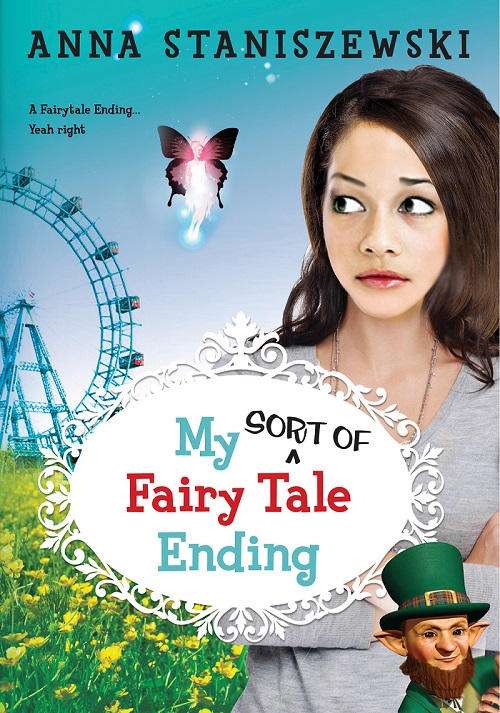Anna Staniszewski, author of the hilarious My Very UnFairy Tale Life series, the most recent of which, called My Sort of Fairy Tale Ending, releases next month, discusses writing middle grade fiction. A topic she is well-versed in. Welcome, Anna!
 How to Write Middle Grade Fiction in Two Simple Steps
How to Write Middle Grade Fiction in Two Simple Steps
What’s the hardest thing about writing middle grade fiction? Being an adult. Really. Your adult self likes to get in the way when you’re writing for 8-12 year olds. Your adult self is judgmental and bossy. It thinks it knows best. Sometimes it won’t shut up.
Here’s my advice when you’re writing middle grade fiction: Try to quiet the adult part of your brain as much as you can and consider these two questions.
1. How can I be the child protagonist?
2. How can I let the child protagonist be him/herself?
Let’s tackle the first question. How can I be the child protagonist? You can’t, right? Because you’re an adult. Well, I’m not sure that’s true. For one, I think many of us have inner children that we can tap into. (And some of us never quite mature beyond the age of thirteen, anyway.)
I’ve found that middle grade books that don’t quite work feel like they were written by an adult instead of told by a child character. To avoid this trap, try to tap into those feelings of what it was like to be the age you’re writing about. Do some journaling as your younger self, if that helps.
Also, do your research. Try to find a (non-creepy) way to spend time with kids and listen to what they talk about, care about, etc. Trust me. This will help. And remember that you’re not writing about all children; you’re writing about one particular character who happens to be in elementary school or—even worse—middle school.
And now on to the second question. How can you let the child protagonist be herself? For one, you need to spend a lot of time working out this specific character, what she wants, what she needs, etc. But also, try to quiet that adult voice that might be tempted to judge your character’s actions or to medicate her or to call her mother.
Because here’s the thing: Your young character might be smart and resourceful, but chances are she has less world experience than you do. She’s going to make mistakes. Maybe big mistakes. Let her. And don’t worry about what kind of example she’s going to set for other kids. If you try to make an example of her, she’ll feel fake. Let her mess up and learn and BE HUMAN. Then she’ll feel real.
So that’s it. How to write middle grade fiction in two simple steps. Easy, right? Not exactly. But when it all comes together, it really is worth it. Trust me. I’m an adult.
My Sort of Fairy Tale Ending blurb:
Happily ever after? Yeah, right. Jenny’s search for her parents leads her to Fairy Land, a rundown amusement park filled with creepily happy fairies and disgruntled leprechauns. Despite the fairies’ kindness, she knows they are keeping her parents from her. If only they would stop being so happy all the time-it’s starting to weird her out! With the help of a fairy-boy and some rebellious leprechauns, Jenny finds a way to rescue her parents, but at the expense of putting all magical worlds in danger. Now Jenny must decide how far she is willing to go to put her family back together.
Born in Poland and raised in the United States, Anna Staniszewski grew up loving stories in both Polish and English. She was named the 2006-2007 Writer-in-Residence at the Boston Public Library and a winner of the 2009 PEN New England Susan P. Bloom Discovery Award. Currently, Anna lives outside of Boston with her husband and their black Labrador, Emma.
When she’s not writing, Anna spends her time teaching, reading, and challenging unicorns to games of hopscotch. She is the author of My Very UnFairy Tale Life and its sequels, My Epic Fairy Tale Fail and My Sort Of Fairy Tale Ending, all published by Sourcebooks Jabberwocky. Look for the first book in Anna’s next tween series, The Dirt Diary, in January 2014, and visit her at www.annastan.com.





















Fantastic approach to writing middle grade, Anna! Always informative (and fun) to have you on the blog.
Thanks so much for having me, Katie!
Wow! Great advice. And your story sounds awesome!!!
Congrats and best of luck!!
Thanks so much, Mary. I’m glad this was helpful!
Thanks for stopping by, Mary!
Excellent advice! It definitely sounds easier than it is though, I think. I swear my inner child hides any time I try to get back into that mentality 🙂
It’s definitely A LOT harder than it sounds. Maybe your inner child will respond to candy? 🙂
So true about the inner child hiding!
For the record, that’s the second time this morning that Anna’s words made me spit out coffee in laughter. It’s really getting over the top, Anna. You’re going to have to be less funny. Do it for the keyboard, Anna. It doesn’t like to be saturated in coffee. 🙂
Sorry. Not gonna happen. Funny for life! 🙂
LOL! Too funny, Heather.
I have a dorky smile on my face as I type this. Anna, if this sense of humor represents your writing style, then your books are must read for anyone in need of a pick me up.
And, it was a smart post too! It always amazed me in my work with parents, how easily people forgot how it was to be a kid. Like the exasperated mother who was losing it when her kids were jumping on the beds. So I asked her, “Um, didn’t you jump on beds when you were a kid?” She stops yelling, and looks at me like a light bulb went off “Hey, it was loads of fun!”
Bingo
May I suggest another good way to evoke emotional memories? Dig out those childhood pictures (and videos) from your mom’s attic and have a look; you’re bound to re-experience the emotions that went along with the event.
Thanks Katie for a funny and helpful guest!
I like the idea of pulling out old pictures and videos. Another way to tap into the inner child is to pull out any writing/journaling you did as a child.
Love the advice about not being tempted to call the child character’s mother! 🙂
I agree, Ann.
Great advice- especially about letting your character make mistakes and not worrying about setting a good example for kids. Letting them see misktakes and then your character working to fix it, is a much better example than a Miss Goody Two Shoes who never puts a foot wrong. B/c kids making mistakes- that’s real! Too bad that doesn’t stop when you become an adult… 😉 One of these days I’m going to tackle a MG novel, and hope it’s half as good as yours turn out, Anna! =)
Really sound advice! Thanks!!